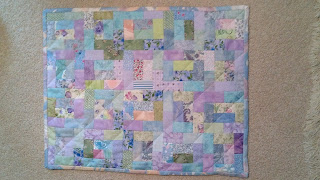There has been so much to learn this month. Thank you Sam at Huntersdesignstudio (here) for organizing this informative, interesting and diverse hop.
My topic for the final day of the hop is Using Leaders and Enders. To the best of my knowledge Bonnie Hunter of Quiltville fame is the individual who came up with this term and I might add took the technique to new heights.
 |
| 56 little windmill blocks made as Leaders and Enders become a small wheelchair quilt. |
Who: Anyone can use Leaders and Enders, but I feel they are most effective for quilters who do piecing on a regular basis. If you chain piece your Foundation Paper piecing you might consider Leaders and Enders but do think about the tiny stitch length you would be using for FPP.
What: A Leader/Ender is purposeful fabric that is ready to put through the sewing machine when the sewer has finished the row of stitching for the primary project they are working on. I like to keep mine short, no longer than 3 1/2", but some people use string blocks as a Leader/Ender. A block for a quilt can be broken down into its components and then each component stitched in stages as a Leader/Ender.
 |
| Four brown and four orange rectangles (1 1/2" x 2 1/2") will make a nice windmill block. |
Where: I like to keep mine to the right of my sewing machine, organized in a variety of ways depending on how big a project is envisioned. Some people organize their Leader/Ender projects in baggies. I like to use the small containers that deli's use for salad. These can be stacked as they are the same size with a recessed lid. A baggie would be easier to use if you were travelling with your sewing. Of course as soon as you say this is how I do it there is an exception.
This small pile is a Broken Dishes quilt in the works. I was gifted a huge bag of triangles. Note, not Half Square Triangles, just triangles. I had to first make them into Half Square Triangles, a good Leader and Ender exercise in itself. Then I squared them all up. These particular HST's were squared at 1 1/2" each. Then I need four that were either the same or played well together. I pinned them together in their groups of four and that is this pile. I have just over 100 little blocks done and these are the remaining block components.
When: You can use a Leader and Ender project when the seam for the primary project is completed. Instead of pulling the thread out and cutting it you take your already prepared L/E project and feed it through the sewing machine without taking a break. This becomes the end for that first task and is in place for the start of the next primary seam to be stitched, hence the name Leader and Ender.
Why: The most obvious reason is to save thread but this strategy also helps to keep your machine sewing needle from coming unthreaded. It goes a long way towards preventing the bunch-up that sometimes happens at the beginning of a seam. Also when you are stitching from one piece to another it helps you to avoid that tail off that sometimes happens at the end of a long seam.
How: There are likely several ways to organize for a Lender/Ender project. My personal preference is to have a short stitching project. I know some people who do string quilts as a L/E. I would not be able to do that comfortably because I like to audition my next string and make sure I am getting my best length and colour string in place. So I spend some time organizing before hand. I have a couple of favourite L/E projects. These require limited thinking once they are set up. the simple Windmills project shown at the top of the post with the orange windmills on a brown background is one great Leader and ender project. You can go completely scrappy or select a colour theme. I look for four blades that are the same and if you have a good value match the background can be scrappy. Think about how you organize your stitching and the types of projects you like to complete. That will give you some guidance in selecting a Leader and Ender project that will work well for you.
This is a finished Broken Dishes doll quilt. Started with triangles, then Half Square Triangles, then pairs of HST's then two pairs together. All tasks that work nicely as Leaders and Enders.
I hope my simple explanation of Leaders and Enders and some of their advantages has convinced you to consider them if you don't already use this approach. Thank you Sam Hunter for including me in this wonderful month of learning. Piecefully, Joanne














